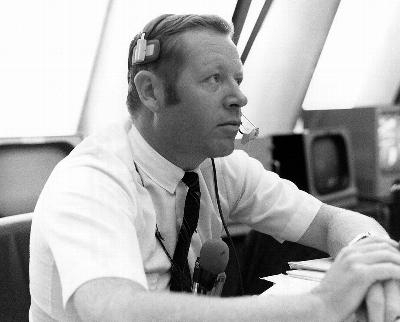Described The Launch Of Apollo 11 To The World
John W. (Jack) King, former chief of Public Information at NASA's Kennedy Space Center, died June 11, 2015 He was 84. A resident of Cocoa Beach, FL, King worked in the space agency's Public Affairs office from 1960 until 1975. He returned to Kennedy in 1997, working for space shuttle contractor United Space Alliance until his 2010 retirement.

King is being remembered by many, including Kennedy's Director, Bob Cabana.
"Jack King counted down the launch of Apollo 11 and all of us watching on television will never forget his calm, reassuring demeanor," said Cabana, a former space shuttle astronaut. "Jack was a true professional and helped us understand in common English the complexities of space flight. He was great at communicating what we do at NASA and he will be missed."
According to Hugh Harris, retired director of NASA Public Affairs at Kennedy, King was instrumental in instituting open communications with the public during the beginning of America's civilian space program.
"Jack helped establish the original systems to ensure the news media received timely and accurate information about both the early human flight programs and the unmanned missions," Harris said.
Born in the Brighton section of Boston, Mass. in April 1931, King was the son of the sports editor for the Associated Press. In 1953 he earned a bachelor's degree in English from Boston College.
King was commissioned as a second lieutenant in the United States Army artillery corps immediately after graduation and served two years in Korea and Japan from 1953 through 1955.
After his military service, King followed in his father's footsteps as a news reporter in the Associated Press Boston Bureau. Shortly after the United States launched its first satellite, Explorer 1, in 1958, King was assigned to cover the fledgling space program from Cocoa Beach, Fla.
In 1960, Kurt Debus, Kennedy Space Center’s first director, hired King to serve as NASA’s chief of Public Information based on his experience as the space reporter and bureau chief for the Associated Press Cape Canaveral Bureau from 1958 to 1959. Many of the launches were classified military rockets and a new mindset was required at the growing launch center.
"The biggest PR job I had to do was with our own people in order to get information that I could pass out to the news media," King said during an interview for an oral history project in June 2002. "These were the early days when things were just starting out."
During that time, the attention of the world and many of America's leaders focused on Cape Canaveral. Three weeks after Alan Shepard became the first American in space on May 5, 1961, President John F. Kennedy raised the sights of the space program even further.
"Right after the Shepard launch is when Kennedy said, let’s go to the moon," King said. "After (John) Glenn was launched ... Kennedy was at (Cape Canaveral) welcoming him back."
King served as manager of press operations for 12 years, spanning the Mercury, Gemini and Apollo programs.
During that time, King was the "voice of launch control" for virtually every human mission from Gemini 4 to Apollo 15. He described countdown events as millions around the world watched the liftoff of the Saturn V rocket that carried the Apollo 11 astronauts to the moon.
In 1972 King became director of Public Affairs for NASA's Johnson Space Center in Houston. There he had wider responsibilities for directing programs that included education outreach, exhibits and astronaut appearances, as well as intergovernmental and community relations.

After the United States and Soviet Union agreed to a mission in which an Apollo spacecraft would link up with a Soyuz in July 1975, King joined a three-member team that negotiated the joint information plan for the Apollo-Soyuz Test Project, or ASTP. The resulting agreement included the first live television coverage of a Russian rocket launch and Soyuz landing at the end of the Russian portion of the flight.
After ASTP, King moved to Washington, D.C., accepting a position as director of Public Affairs for the Department of Energy Research and Development to build an agency wide publicity program in solar, fossil and nuclear energy.
King left government service in 1977 to work for Dr. Armand Hammer, chairman of Occidental International Corp. for whom he developed and implemented a wide-ranging public relations program. He also served as the chairman's speech writer and coordinator of media events in connection with his numerous travels and philanthropic activities.
After Hammer's death in December 1990, King served as vice president of Powell Tate, a leading communications and public affairs firm in Washington, specializing in defense, space technology and energy issues.
King returned to Florida's Space Coast in 1997, assuming responsibilities for news media relations for United Space Alliance (USA), NASA's prime contractor for day-to-day Space Shuttle Program operations.
King was a two-time recipient of the NASA Exceptional Service Medal and winner of the Aviation/Space Writer's Lawrence Award as the outstanding U.S. government public information officer in 1969. In 2000 he was one of the first two recipients of the Harry Kolcum Memorial News and Communications Award presented by the National Space Club Florida Committee, recognizing the highest standards in journalism and public affairs work.
King retired from USA in October 2010, but continued to serve as a NASA public affairs volunteer.
A widower, King and his wife Evelyn were married 39 years prior to her death in 2005. They had three children and five grandchildren.
(NASA Images)
 Unfortunate... ANN/SportPlane Resource Guide Adds To Cautionary Advisories
Unfortunate... ANN/SportPlane Resource Guide Adds To Cautionary Advisories ANN FAQ: Turn On Post Notifications
ANN FAQ: Turn On Post Notifications ANN's Daily Aero-Term (04.29.24): Visual Approach Slope Indicator (VASI)
ANN's Daily Aero-Term (04.29.24): Visual Approach Slope Indicator (VASI) ANN's Daily Aero-Term (04.28.24): Airport Marking Aids
ANN's Daily Aero-Term (04.28.24): Airport Marking Aids ANN's Daily Aero-Linx (04.28.24)
ANN's Daily Aero-Linx (04.28.24)




